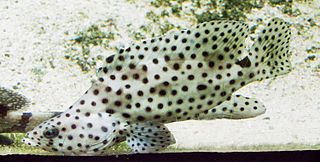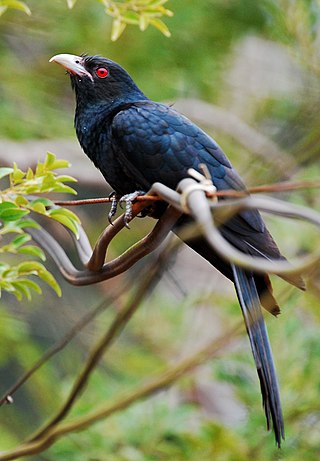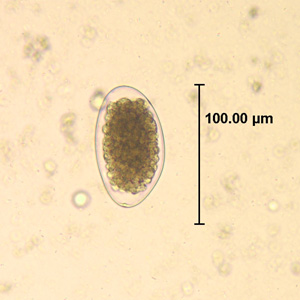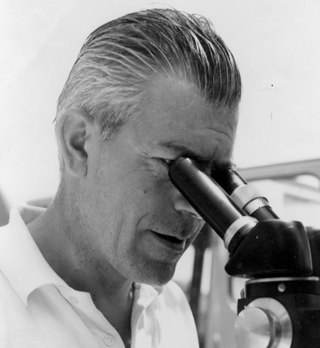
The Serranidae are a large family of fishes belonging to the order Perciformes. The family contains about 450 species in 65 genera, including the sea basses and the groupers. Although many species are small, in some cases less than 10 cm (3.9 in), the giant grouper is one of the largest bony fishes in the world, growing to 2.7 m in length and 400 kg (880 lb) in weight. Representatives of this group live in tropical and subtropical seas worldwide.

Gaston Louis Alfred Leroux was a French journalist and author of detective fiction.

The Asian koel is a member of the cuckoo order of birds, the Cuculiformes. It is found in the Indian Subcontinent, China, and Southeast Asia. It forms a superspecies with the closely related black-billed koels, and Pacific koels which are sometimes treated as subspecies. The Asian koel like many of its related cuckoo kin is a brood parasite that lays its eggs in the nests of crows and other hosts, who raise its young. They are unusual among the cuckoos in being largely frugivorous as adults. The name koel is echoic in origin with several language variants. The bird is a widely used symbol in Indian and Nepali poetry.

The Trichocephalida is an order of parasitic nematodes.
Acanthocheilonema is a genus within the family Onchocercidae which comprises mainly tropical parasitic worms. Cobbold created the genus Acanthocheilonema with only one species, Acanthocheilonema dracunculoides, which was collected from aardwolf in the region of South Africa in the nineteenth century. These parasites have a wide range of mammalian species as hosts, including members of Carnivora, Macroscelidea, Rodentia, Pholidota, Edentata, and Marsupialia. Many species among several genera of filarioids exhibit a high degree of endemicity in studies done on mammalian species in Japan. However, no concrete evidence has confirmed any endemic species in the genus Acanthocheilonema.
Mammomonogamus is a genus of parasitic nematodes of the family Syngamidae that parasitise the respiratory tracts of cattle, sheep, goats, deer, cats, orangutans, and elephants. The nematodes can also infect humans and cause the disease called mammomonogamiasis. Several known species fall under the genus Mammomonogamus, but the most common species found to infest humans is M. laryngeus. Infection in humans is very rare, with only about 100 reported cases worldwide, and is assumed to be largely accidental. Cases have been reported from the Caribbean, China, Korea, Thailand, and Philippines.

The Strongylida suborder includes many of the important nematodes found in the gastrointestinal tracts of ruminants, horses, and swine, as well as the lungworms of ruminants and the hookworms of dogs and cats.
The following is a list of players, both past and current, who appeared at least in one game for the Los Angeles Dodgers National League franchise (1958–present), and for the Brooklyn-based teams known as the Atlantics (1884), Grays (1885–1887), Bridegrooms, Grooms (1891–1895), Superbas (1899–1910), Dodgers and Robins (1914–1931).

Trichostrongylus species are nematodes, which are ubiquitous among herbivores worldwide, including cattle, sheep, donkeys, goats, deer, and rabbits. At least 10 Trichostrongylus species have been associated with human infections. Infections occur via ingestion of infective larvae from contaminated vegetables or water. Epidemiological studies indicate a worldwide distribution of Trichostrongylus infections in humans, with the highest prevalence rates observed in individuals from regions with poor sanitary conditions, in rural areas, or who are farmers / herders. Human infections are most prevalent in the Middle East and Asia, with a worldwide estimated prevalence of 5.5 million people.

Hassalstrongylus is a genus of nematode worms that infect mostly muroid rodents from eastern North America to South America. The genus is part of the Heligmonellidae and related to genera like Stilestrongylus.

Opisthorchiidae is a family of digenean trematodes. Opisthorchiidae have cosmopolitan distribution.
Maurice Neveu-Lemaire was a French physician and parasitologist.

Alain Chabaud was a French parasitologist, mainly a specialist of nematodes and sporozoa. He was the Director of the Laboratoire de Zoologie (Vers) in the Muséum National d'Histoire Naturelle in Paris from 1960 to 1989. He was one of the founders of the Société Française de Parasitologie in 1962 and its president until 1975, and president of the Société zoologique de France in 1967.

The I.I. Schmalhausen Institute of Zoology of National Academy of Sciences of Ukraine is the leading institution in Ukraine doing research in zoology. At present, this is the leading regional center of zoological research and expertise in the Eastern Europe.
Ostertagia ostertagi, commonly known as the medium stomach worm or brown stomach worm, is a parasitic nematode of cattle. O. ostertagi can also be found to a lesser extent in sheep, goats, wild ruminants, and horses. It causes ostertagiosis, which is potentially fatal in cattle. It is found worldwide and is economically important to cattle industries, particularly those found in temperate climates.

František Moravec is a Czech parasitologist who specialises on the Nematodes, especially the nematodes parasites of fishes. His research is mainly in the field of taxonomy of the Nematoda.

Jean-Lou Justine, French parasitologist and zoologist, is a professor at the National Museum of Natural History in Paris, France, and a specialist of fish parasites and invasive land planarians.
Molineidae is a family of nematodes belonging to the order Rhabditida.

Robert-Philippe Dollfus was a French zoologist and parasitologist.













